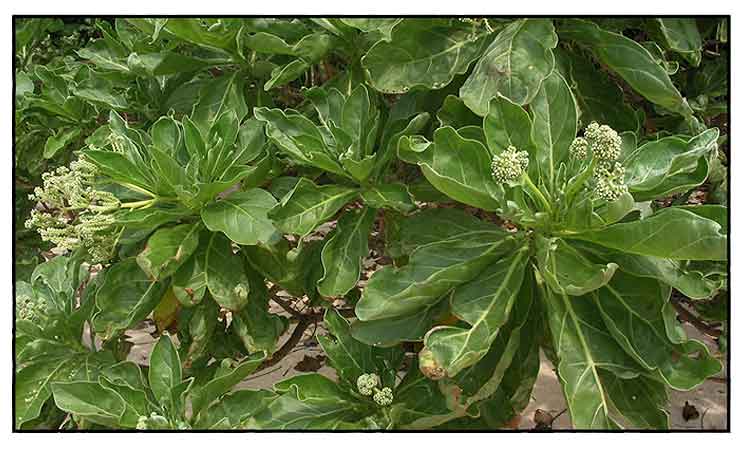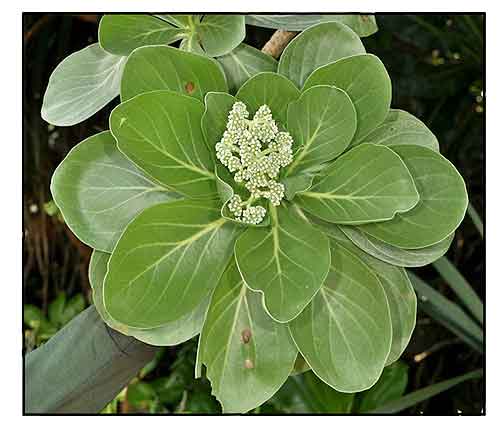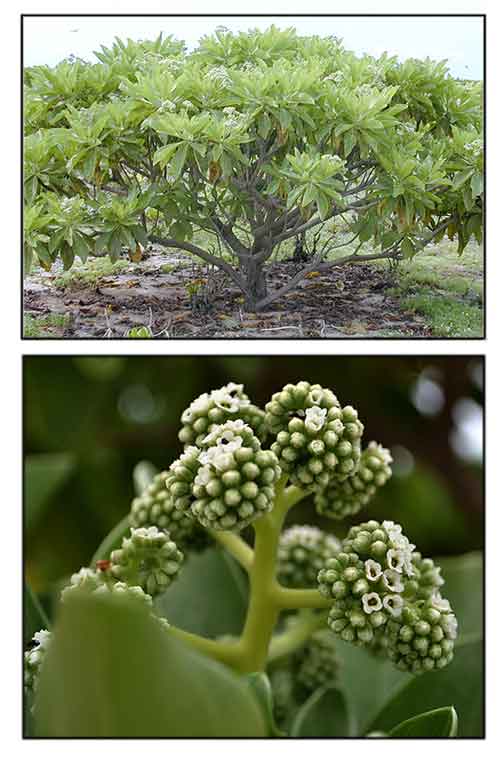
Family • Boraginaceae
Patayud
Heliotropium arboreum (Blanco) Mabb.
TREE HELIOTROPE / OCTOPUS BUSH
| Scientific names | Common names |
| Argusia argentea (L.f.) Heine | Patayud (Tagalog) |
| Heliotropium arboreum (Blanco) Mabb. | Beach heliotrope (Engl.) |
| Heliotropium foertherianum Diane & Hilger | Octopus bush (Engl.) |
| Messerschmidia argentea (L.f.) I.M.Johnst. | Tree heliotrope (Engl.) |
| Aspidopterys ovata (Turcz.) Merr. | Veloutier (Engl.) |
| Tournefortea arborea Blanco | Velvetleaf soldier bush (Engl.) |
| Tournefortea argentea L.f. | |
| Heliotrpoium foertherianum is a synonym of Heliotropium arboreum. | |
| Heliotrpoium arboreum is an accepted species. KEW: Plants of the World Online | |
| Tree heliotrope as common name is shared by both Heliotropium arboreum and H. sarmentosum. | |
| Other vernacular names |
| HAWAI'I: Tahinu. |
| SINHALA: Karan. |
Botany • Growth form: Slow growing tree to 6m tall, rarely to 12m. Foliage: Leaves oblanceolate to obovate, silvery green, pubescent, 10-30cm long by 3-12cm wide. Flowers: Inflorescence in paniculate or scorpoid cymes. Flowers white, to 0.5- 0.6cm across, pubescent. Fruits: Fruits 0.5-0.8cm across, ripening greenish orange. (3)
Constituents Properties Availability |
July 2024
![]()
 |
| PHOTOS / ILLUSTRATIONS |
| IMAGE SOURCE: Boraginaceae : Heliotropium arboreum / Flowering branches / Copyright © 2011 by Leonardo L Co [ref. DOL27111] / Non-Commercial Use / Image modified / Click on image or link to go to source page / Phytoimages.siu.edu |
| OTHER IMAGE SOURCE: Heliotropiaceae : Heliotropium arboreum / Flowering twig / Copyright © 2014 by P B Pelser & J F Barcelona (contact: [email protected]) [ref. DOL85817] / Non-Commercial Use / Click on image or link to go to source page / Phytoimages.siu.edu |
| OTHER IMAGE SOURCE: Flower of Heliotropium foertherianum / Mullokkaaran / CC BY-SA 3.0 / Click on image or link to go to source page / Wikipedia |
| OTHER IMAGE SOURCE: Tournefortia argentea habit / Forest & Kim Starr / CC BY 3.0 / Click on image or link to go to source page / Wikipedia |
Additional
Sources and Suggested Readings |
• |
DOI: It is not uncommon for links on studies/sources to change. Copying and pasting the information on the search window or using the DOI (if available) will often redirect to the new link page. (Citing and Using a (DOI) Digital Object Identifier) |
| List of Understudied Philippine Medicinal Plants |
| New plant names needed The compilation now numbers over 1,300 medicinal plants. While I believe there are hundreds more that can be added to the collection, they are becoming more difficult to find. If you have a plant to suggest for inclusion, native or introduced, please email the info: scientific name (most helpful), local plant name (if known), any known folkloric medicinal use, and, if possible, a photo. Your help will be greatly appreciated. |
• |
 |



 Uses
Uses